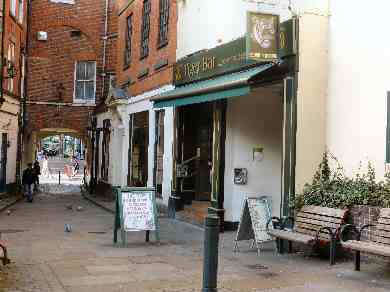CATHEDRAL QUARTER TRAILS - VICTORIA STREET
DERBY CATHEDRAL QUARTER – 4 VICTORIA STREET
Stylish, independent shops, great places to eat and drink, valued professional services and impressive historical landmarks. Derby’s Cathedral Quarter has it all.
Looking across Victoria Street
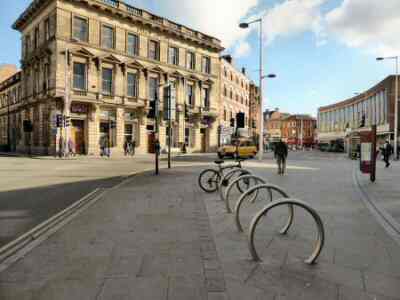
Until the early part of the 19th century, the Markeaton Brook was an open waterway. Flowing through Derby. Before culverting in the 1830s, it was navigable for small boats as far as Brook Walk. For the delivery and collection from the mills in the area. The problems were that the brook flooded and also all manner of foul-smelling waste was deposited in the water.
The section linking St James’ Bridge, at the end of St James’ Street and St. Peter’s Bridge at the intersection of Peter’s Street and the Corn Market was known as Brookside. In addition to St Peter’s Bridge. A further footbridge led to the County Gaol, which had been built across the brook between St Peter’s Street and the Corn Market. This was known as the Gaol Bridge.
In 1837, the brook was covered with a brick culvert and by 1841, it had been renamed Victoria Street. Culverting of what we now know as, Albert Street and The Strand followed later. The creation of these new streets brought benefits to the local community. This led to the building of some extremely fine Victorian buildings.
Although Markeaton Brook was lost to sight when culverting took place, St Peter’s Bridge was not destroyed. When works were undertaken in October 2004 to strengthen the culvert the bridge reappeared. This caused a great deal of interest locally, with some people even comparing Derby to Venice.
The brook made an even more dramatic appearance in 1939. When an unfortunate accident led to a steamroller crashing through into the water under the Strand. Clearly visible by the hole was a sign “Locomotives Prohibited”.
The Old Post Office
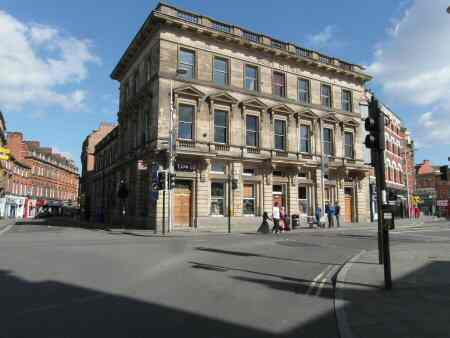
After Markeaton Brook had been culverted, St James Lane was widened and renamed St James’ Street. It soon became an elegant shopping thoroughfare and a stopping place for public transport. The street closed in the 1990s to all-through traffic and the Corn Market end was paved.
In 1869 the General Post Office occupied the corner site with Victoria Street. Before being moved further along Victoria Street, then moving again to Babington Lane, in May 2013. The 1869s Post Office’s name is still visible on the front.
Former Debenhams (part of St Peter’s Quarter)
An important building in Victoria Street was the former Debenham’s Departmental Store before moving to the currently named Derbyion in 2007. It had an interesting curved shaped frontage and was the home of Silly Sid’s furniture shop for a time.
Before Debenham’s operated from the site, Ranby’s Departmental Store traded from the same location. The building was demolished recently to make way for redevelopment.
The departure of Woolworths and Debenham a few years later, combined to reduce footfall and diminished the street’s importance as a shopping venue. Victoria Street starts and Albert Street ends at the intersection between the Corn Market and St Peter’s Street. It was named after Queen Victoria and like its neighbour came into being as a result of the culverting of Markeaton Brook.
Royal Hotel
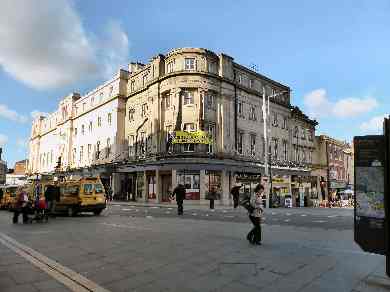
The Royal Hotel, on the corner of the Corn Market and Victoria Street, was built in 1837 by Robert Wallace, after he won a competition to design it. In total 52 architects’ submitted proposals, from which Wallace was chosen, to design a group of buildings, originally consisting of a hotel, the Athenaeum and a Post Office. He had also been selected to design the Derby and Derbyshire Bank, which was adjacent to the proposed new development, which meant he could easily merge the two projects.
The Athenaeum Society premises which faced Victoria Street were the home to a newsroom where the latest editions of some 18 different newspapers and journals were available for members to study. It also housed the new Town and Country Museum.
After the completion of the building, the Royal Hotel soon became the town’s leading location for visitors and a popular place for public celebrations. In 1869, the Post Office moved to new premises on the corner of Victoria Street and St James’ Street. In 1951, the Royal Hotel said farewell to its last guests.
Looking up the Corn Market
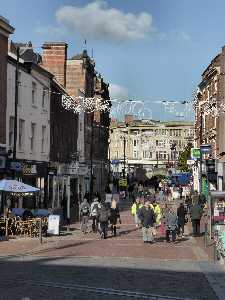
The Corn Market is noticeably wider at the bottom end which faces St Peter’s Street. It was deliberately constructed like this so as to be able to accommodate the Grain Market. Here, merchants placed samples of grain in containers sited on posts so that potential buyers could test them before purchasing. The market continued to operate in the Corn Market until the Corn Exchange was built on Albert Street.
Entrance to Lock-Up Yard
Lock-up Yard was once the scene of the brutal murder of a policeman. On 12 July 1879, Gerald Mainwaring, after drinking heavily, set off driving a horse and trap through the streets of Derby. He was accompanied by a prostitute, Annie Green, and with Mainwaring flogging the pony and both occupants laughing and shouting at passers-by, the police at first tried and failed to check their progress.
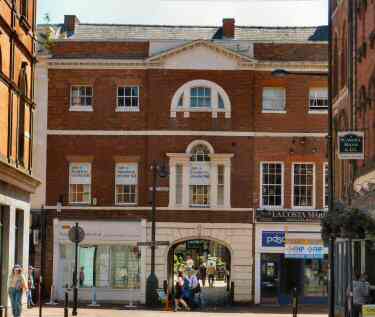
Eventually, the pair were apprehended in the yard of the Traveller’s Rest Public House on Ashbourne Road. They were taken back to the police station in Lock-up Yard, where they were charged with being drunk and disorderly. Unfortunately, they were not searched and when Annie Green took exception to being locked up, she hit one of the policemen on the jaw, the officers then moved to restrain her.
At that point, Mainwaring produced a pistol and shot PC Moss, who subsequently died. He also shot at and injured another officer. Mainwaring was sentenced to be hanged. But the decision was made on the toss of a coin by the foreman after the jury had been unable to reach a verdict. This came to the notice of the local paper and the editor contacted the Home Secretary. Who commuted the sentence to life imprisonment, ruling that a man should not be hanged based on the toss of a coin.
Steve Bloomer Memorial
The memorial to Steve Bloomer was unveiled on 28 October 1996, in Lock-up Yard. Bloomer’s 28 goals in 23 England games gave him a then-unique average of 1.21 per cap. The son of a Midlands blacksmith, Bloomer was a pupil at St James’ School in Derby. He was described as a working-class hero by Nottingham Trent University Student Jonathan Belshaw in his 1990s study of Victorian Social Changes.
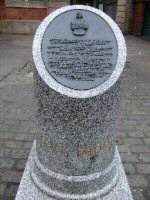
His career began with Derby County in 1892, before leaving to play for Middlesbrough in 1906. The team had a disastrous time without his services and suffered relegation as a result. In 1910, they re-signed him and in the first full season after his return, they were promoted. He continued playing for the club for four more years before ending his playing career in 1914.
A statue in memory of Steve Bloomer was unveiled at Pride Park, the new home of Derby County Football Club, in January 2009. It was erected by his friends and admirers in appreciation of the service he gave to Derby County.
Tiger Bar
Opposite St James Street, in the Lock-up Yard, is the Tiger public house. It dates from 1737 when it operated as a coaching inn and was originally much larger. It was used by travellers between London and Manchester when the frontage stretched as far as the Corn Market. The building now reduced in size was restored in 1990.
It was a popular stopping place for parties on ghost walks. The Tiger Bar provides access for a subterranean trip down into the Derby Catacombs, barrel-vaulted tunnels beneath the Guildhall. Where during the Victorian era tunnels were used to convey prisoners. Between the Police Station in ‘Lock-up Yard’ and the Courts of Assize, which were held at the Guildhall. One of the best-remembered to be escorted through the tunnels was Alice Wheeldon, a left-wing revolutionary, from Pear Tree in Derby. She was the key individual allegedly involved in a plot to assassinate Prime Minister, Lloyd George, in 1917. Wheeldon was captured and tried at the Assize Court and given a ten-year sentence, while her co-conspirators got lesser terms.
In January 2012, the BBC reported on a campaign to clear Alice Wheeldon’s name. It appeared that Wheeldon and her co-conspirators had planned to free prisoners whose only crime was to oppose the war. The strychnine that she had obtained was to kill the guard dogs at the Detention Centre. Where the conscientious objectors were being held so that they could be freed. It was not to be used to assassinate the Prime Minister. Her ghost is said to haunt the labyrinth of tunnels beneath the Guildhall.
